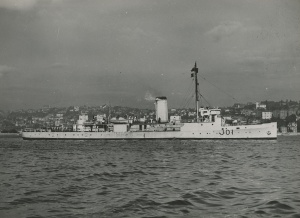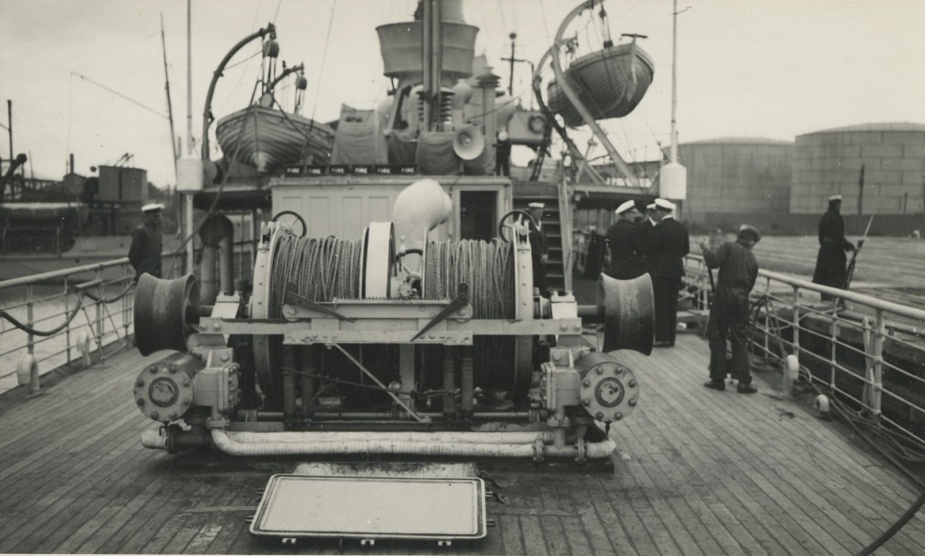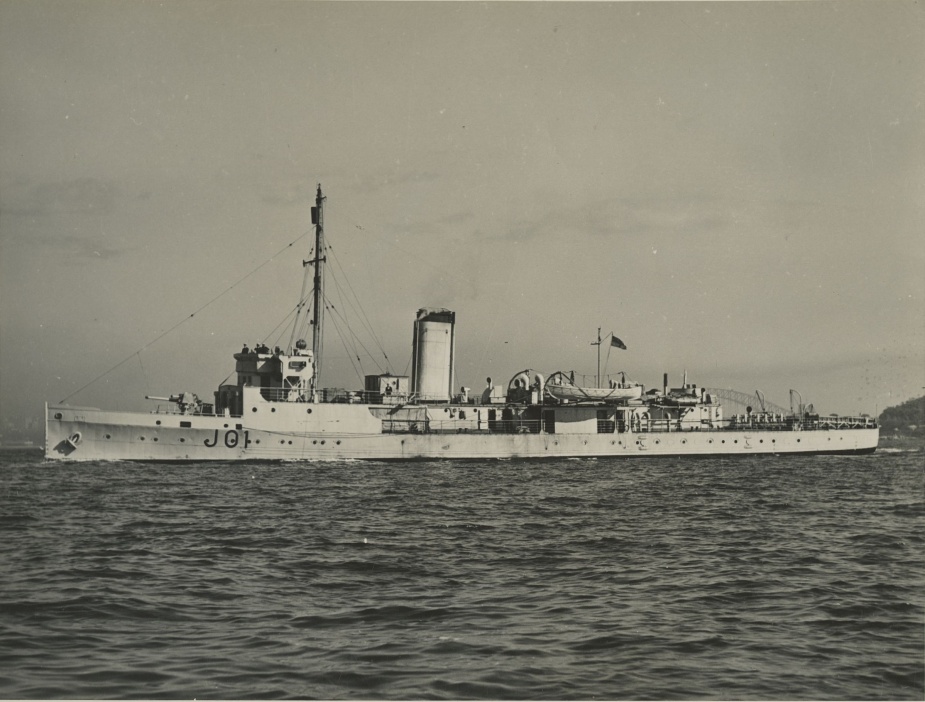HMAS Doomba
| Class |
Hunt Class Minesweeper |
|---|---|
| Pennant |
N01 (Later J01) |
| Nickname |
Smoky Joe |
| Motto |
I Shall Either Find Or Make A Path |
| Builder |
William Simons & Co Ltd shipyard, Renfrew, Scotland |
| Commissioned |
25 September 1939 |
| Decommissioned |
13 March 1946 |
| Dimensions & Displacement | |
| Displacement | 800 tons |
| Length | 70.4 metres |
| Beam | 8.7 metres |
| Draught | 2.4 metres |
| Performance | |
| Speed | 16 knots |
| Range | 1500 nautical miles |
| Complement | |
| Crew | 5 Officers, 89 Sailors (on commissioning) |
HMAS Doomba began her seagoing career as the minesweeper HMS Wexford, one of 115 Hunt Class minesweepers built for the Royal Navy in the later part of World War I (she was part of the second or Abadare group of the Hunt Class). Wexford was ordered in mid-1917 and constructed at William Simons & Co Ltd shipyard in Renfrew, Scotland. She was launched on 10 October 1919 and commissioned the same year: named after the town of Wexford, Ireland (then part of the United Kingdom). The Hunt Class had a shallow draft (2.4 metres) to aid in minesweeping and equipped with Oropesa floats to cut the cables of moored mines.
Wexford was armed with a single 4-inch quick firing gun mounted forward and 12-pounder quick firing gun aft as well as two twin .303 machine guns. Her triple expansion steam engines were powered by two forced draft coal fired Yarrow water tube boilers designed to burn high quality Welsh steaming coal. However, the Hunt Class were renowned for producing excessive smoke and were known colloquially as ‘Smoky Joes’. Wexford was employed sweeping minefields in the post-war period and was decommissioned in late 1921 and laid up in reserve. She was sold on 26 November 1921 to the Stanlee Shipbreaking and Salvage Co Ltd of Dover and arrived at Devonport on 21 April 1922 for breaking up.
She was saved from the breakers yard and on-sold to Coaster Construction Co Ltd of Montrose and converted to a passenger vessel for the Doomba Shipping Company (Brisbane, Queensland). Arriving in Brisbane in 1923 she was renamed Doomba and her main task was carrying tourists from Brisbane to Redcliffe and Bribie Island. She was later sold to the Brisbane Tug and Steamships Co Ltd and at times, particularly during the Great Depression, was laid up or conducted limited service due to a lack of work. In early 1939, Doomba was laid up at Peters Slip at Kangaroo Point in Brisbane.
With the outbreak of war on 3 September 1939, the former minesweeper was immediately requisitioned by the Royal Australian Navy. She was commissioned as HMAS Doomba on 25 September 1939, under the command of Lieutenant Commander Max Clark, RAN (a graduate of the 1920 entry to the RAN College). On 30 September Doomba sailed south to Sydney to be fitted out as a minesweeper with a single 4-inch gun mounted forward and two .303 Lewis machine guns also fitted (depth charge racks were later fitted as well). The refit finished in late November and, following equipment trials, she headed south to Melbourne arriving at Williamstown Naval Depot on 5 December 1939. On 22 December HMA Ships Swan, Yarra, Doomba and Orara became the 20th Minesweeping Flotilla based at Port Melbourne, Victoria.
One of the flotilla’s first tasks was to conduct a sweep of Bass Strait, in early January 1940, prior to the transit of the first Australian troop convoy (US.1) on its way to the Middle East. On 11 January Doomba and Orara swept ahead of the ten ship convoy, carrying thousands of soldiers, as it negotiated the narrow swept channel off Wilsons Promontory. No mines were found as German raiders had not yet reached Australian waters at this early stage of the war. Doomba and Orara continued to operate in southern Australian waters throughout 1940 keeping the sea lanes open for both merchant shiping and troop convoys (Convoys US.2 in April, US.3 in May and US.4 in August). It was hard repetitive work often in bad weather but essential to ensure shipping - the lifeblood of the nation - kept moving safely. Doomba also regularly embarked gunnery sailors from Flinders Naval Depot for training, using her 4-inch gun, and Cadet Midshipmen from the RAN College (also located at Flinders Naval Depot) for day trips to sea. In 1940 Doomba was purchased outright by the RAN for £12,000.
No mines were found during her sweeping operations but it would not be long before German raiders became active in Australian and New Zealand waters. On 18 June 1940 the RMS Niagara departed Auckland bound for Canada, but in the early hours of the 19th, while transiting the Hauraki Gulf, she struck a mine laid by the German raider Orion on the night of 13/14 June. No lives were lost but soon after two more mines were located by New Zealand minesweepers and the Hauraki Gulf closed to shipping. News of the minefield was quickly communicated to the Australian Naval Board and the 20th Minesweeping Flotilla commenced sweeping operations in South Australian and Victorian waters. During World War I the German Raider Wolf had mined Bass Strait and it was thought that this was the most likely location for mines to be found. Doomba, and the other minesweepers, swept for mines as far west as the Spencer Gulf (South Australia) as well as Bass Strait and southern New South Wales waters but with no result. In mid-October 1940 Doomba proceeded to Sydney for maintenance which was not completed until late December of that year.
In late October 1940 the German raider Pinguin entered Australian waters laying minefields between Newcastle and Sydney, off Hobart, in Banks Strait, off Wilsons Promontory and Cape Otway and finally in Spencer Gulf off Adelaide. Pinguin then headed west into the Indian Ocean to attack other targets and it was not until the early hours of 8 November 1940 that her mines claimed their first victim – the steamer Cambridge which struck a mine and sank in Bass Strait. Within 24 hours another merchant ship, the City of Rayville (the first US ship lost in the war), struck a mine at the western entrance to Bass Strait and sank with the loss of one life. The minefields north of Sydney were found on 5 December when the cargo ship Nimbin struck a mine and sank off Norah Head, killing seven of her crew. Doomba returned to sweeping duties on 29 December 1940 and headed south to sweep for mines off Hobart. The entrance to the port was cleared and while working with the sloop HMAS Warrego one German mine was destroyed.
Doomba then returned to sweeping duties in Bass Strait with Warrego, Swan, Orara, and other auxiliary minesweepers, until November 1941 and while Doomba only swept two mines in Bass Strait, both of which she destroyed with rifle fire, there were no more ships lost in Bass Strait. Many of the mines laid were never located and were believed to have broken their mooring cables, in bad weather, and drifted out into the open ocean and away from the main shipping lanes.
Life in the Bass Strait minesweepers was hard work, with constant sweeping in bitter weather conditions in old coal burning vessels. Doomba operated mainly from Port Welshpool during 1941, and when in port the ship had to be coaled which was dirty and laborious work along with the necessary maintenance performed on the ship and machinery. Doomba was widely known as ‘Smoky Joe’, as her plume of black smoke heralded her arrival long before the ship could be seen. Port Welshpool provided the crew with some relaxation with its cinema, hotel and sporting facilities. Doomba's crew were able to play tennis, golf and Australian Rules Football. Christmas Day 1941 was initially spent at sea until 2pm when Doomba anchored off Portsea and non-duty personnel proceeded ashore for recreation; the ship sailed for more sweeping duties early the following morning.
In early 1942 Doomba steamed to Sydney and docked at Chapman’s slipway, in Balmain, for conversion to an anti-submarine patrol vessel. This work was completed in late May 1942 and she commenced her sea trials on 27 May including test firing of her newly fitted 20mm Oerlikon guns. Doomba was alongside Garden Island Dockyard, outboard of the light cruiser HMAS Adelaide, on the night of 31 May/1June 1942 when three Japanese midget submarines entered the harbour and attacked shipping. While her ships company were ‘stood to’ Doomba did not take an active part in the counter-attacks on the midget submarines although members of her crew sighted one of the submarines off Robertson Point at about 0450. The attack on Sydney Harbour heralded a new phase in the maritime campaign, on the Australian east coast, with German mines replaced by Japanese submarine attacks.
Early on the morning of 12 June 1942 an eight ship convoy, CO.2, escorted by the destroyer USS Perkins and the corvette HMAS Whyalla, was en route from Newcastle, NSW to Melbourne when the Panamanian registered steamer Guatemala, which had been straggling behind the main group, was torpedoed by the Japanese submarine I-24. The steamers crew abandoned ship in good order and Guatemala sank at about 2:30am. Her entire crew of 51 were picked up later that day by Doomba and taken to Sydney. By July of that year Doomba was based at Newcastle for port defence and convoy escort duties. On the morning of 23 July she went to the aid of the coastal steamer Allara, bound for Sydney with a cargo of sugar, which had been torpedoed by the Japanese submarine I-174. Allara had several crew killed and injured and her rudder and propellers destroyed. Attempts by Doomba to tow the stricken ship into Newcastle failed and two tugs, Heroic and St Hillary, from Newcastle were dispatched to bring the badly damaged ship into port. Two of Doomba’s personnel (Leading Steward Leslie Stanley and Sick Berth Attendant Clarence Gurney) were transferred to Allara to help treat her injured personnel.
Doomba returned to Victorian waters in late July 1942 and was based in Melbourne undertaking anti-submarine patrols and convoy escort duties in Bass Strait. These mundane but essential duties continued until mid- December 1943 when she headed north again to Sydney. After arriving at Port Jackson Doomba commenced regular anti-submarine patrol duties between Sydney and Smoky Cape (south of Coffs Harbour). She continued this duty until late June 1944 when she proceeded to Brisbane for a refit. In early September 1944 Doomba replaced HMAS Bingera as the seagoing training ship at Flinders Naval Depot (HMAS Cerberus) and carried out this role until the end of the war.
HMAS Doomba was decommissioned on 13 March 1946 and subsequently sold in early 1947 to Penguin Ltd shipbreakers who stripped the vessel of her superstructure and engines. In the early 1950s the hull was converted into a ‘dumb lighter’ for use as a bulk linseed oil barge for the Sydney based vegetable oil merchant Meggitt Ltd. Renamed Meggol, she was used in Sydney Harbour to store and move bulk oil unloaded from tankers to the Meggitt Ltd factory on the Parramatta River. Meggol was laid up in Homebush Bay in 1970 and sold for breaking up. This was not to be and the ship avoided the breakers yard for the second time in her long career. On 9 December 1976 she was towed out of Sydney Harbour and scuttled off Dee Why to help form an artificial reef. She rests there to this day.





